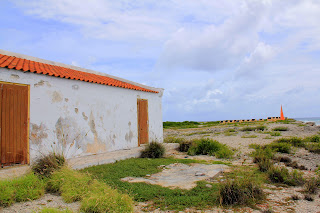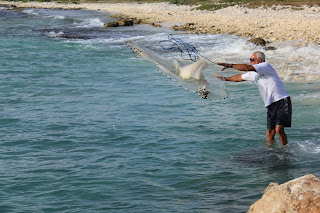Herds of wild Donkeys and Goats. Goats everywhere. Like chickens on Kauai almost. Then there's the flamingos and parrots and pelicans and frigate birds. And we already discussed the reptiles- iguanas, whiptail lizards and the geckos that only hang out by the outside lights at night.
Let's start with the Salt Pan. Bonaire once was a leader in salt production and distribution. Since the trade has slowed down a bit, it leaves piles and piles of salt in stark white mounds waiting to be loaded and shipped. There is no fresh water supply on the island, so they have a huge desalination plant that takes the salt water in, strips out the salt by crystalization and then pipes the now fresh water into homes and businesses throughout Bonaire. It is completely safe and very good drinking water, but very expensive as you can imagine.
So then we see further south, slave huts. These huts housed 2 slaves who worked the salt mines 5 days a week and were allowed to walk home to their families in Rincon on the weekends (a 7 hour walk!!). Slavery was abolished in 1863, but the huts still stand next to their past plantation owners villas on the west coast. There was the "white" and "red" slave hut differentiations.
The surf got rougher and rougher the further south we went, but we did see donkeys and goats and flamingos and pelicans and even some osprey and frigate birds. But I'll do a post separately about them.















No comments:
Post a Comment